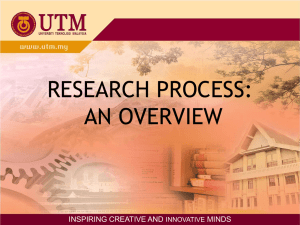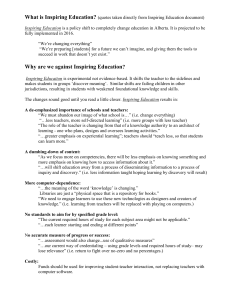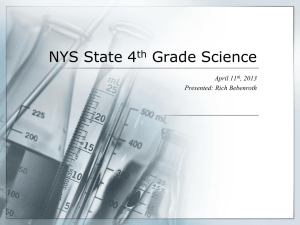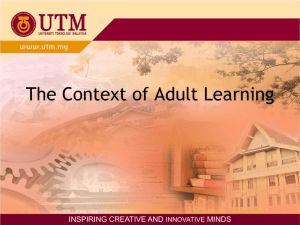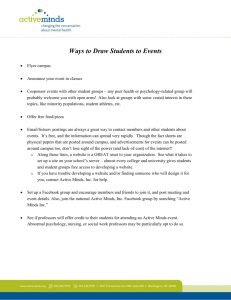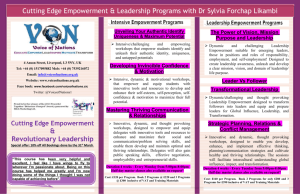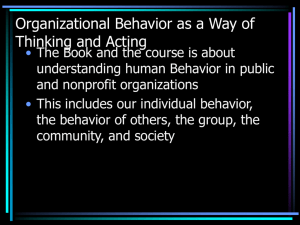UNP0010 Part 2
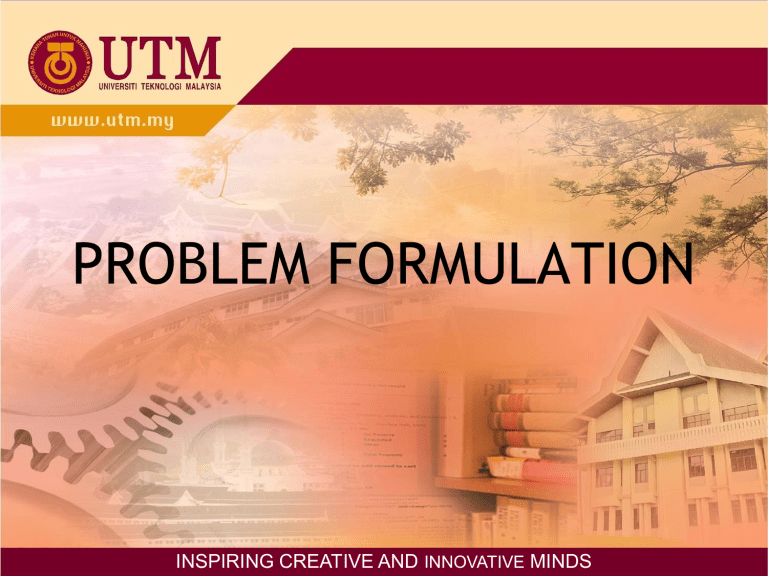
PROBLEM FORMULATION
INSPIRING CREATIVE AND INNOVATIVE MINDS
What is a Research Problem?
A research problem is basically a “gap” between “what is “ and “what ought to be”.
Tips : i.
Find out why the information is being sought ii.
Determine whether the information already exist iii. Determine whether the question really can/should be answered iv. Use exploratory research to define background of the problem v. Situation analysis vi. The iceberg principle vii. Determine relevant variables.
2
INSPIRING CREATIVE AND INNOVATIVE MINDS
Criteria for Selecting A Problem
1. Interest: Commit yourself to a research.
2. Size: Manageable & doable.
3. Economical: Time and money.
4. Researcher’s Capabilities & Limitations.
5. Uniqueness: Do not duplicate; similar but differentiated by method, design or sample or perform different statistical analyses.
3
INSPIRING CREATIVE AND INNOVATIVE MINDS
Criteria for Selecting A Problem
6. Start with theories/set of ideas :- easier to start. The outcome might be a critique to the theory, suggestions how it can be modified or extended
7. Potential & sufficient outcomes :- valuable results.
Even if you plan to develop something in the end which might not be achievable the knowledge developed in the process still has contribution within the indicated period (3++ years?)
8. Not bias, safe & ethical :- be objective as much as possible, not causing discomfort & harm to anyone/anything (social, emotional, physical).
4
INSPIRING CREATIVE AND INNOVATIVE MINDS
Is the problem researchable?
The questions include:
Has the problem been specified?
Is the problem amenable to research?
Is the problem too large?
How is the availability of the data?
Am I capable of solving the problem?
5
INSPIRING CREATIVE AND INNOVATIVE MINDS
A research aim is to do: i.
To clarify an existing theory ii.
To clarify contradictory findings iii. To correct a faulty methodology iv. To correct the inadequate or unsuitable use of statistical techniques v. To reconcile conflicting opinions vi. To solve existing practical problems.
INSPIRING CREATIVE AND INNOVATIVE MINDS
6
Quality of the Proposed Research
• Show a thorough knowledge of relevant prior research.
• Prior research is related to the proposed research.
• Comprehensiveness and appropriateness of the research design.
• Appropriateness of the instrumentation and methodology.
• Appropriateness of the anticipated analyses.
• The likelihood that the proposed research can be completed successfully as described.
7
INSPIRING CREATIVE AND INNOVATIVE MINDS
Research Process: The Scientific Method
• Step 1: State the Problem ( Problem
Formulation)
• Step 2: Background & Literature study about the problem.
(Literature Review)
• Step 3: Form a Hypothesis (Data Collection)
• Step 4: Do experiment that test the hypothesis.
(Analysis & Findings)
• Step 5: Draw a conclusion.
(Derive
Conclusions)
8
INSPIRING CREATIVE AND INNOVATIVE MINDS
HOW TO SELECT A PROBLEM?
• Personal practical experience.
• Previous or prior work on subject.
• Own curiosity or own great mind
• Critical Study of the literature search.
• New technology.
• Interaction with other researchers in the community eg correspondence, seminars, conferences, colloquium, etc.
9
INSPIRING CREATIVE AND INNOVATIVE MINDS
Research Problem
General
Background/Problem
Statement of
Problem /
Analysis
Research
Questions/
Finding
10
Will the result be significant?
• The questions include:
Will the result advance knowledge?
Will the research have some value?
Will the results be of interest to others?
INSPIRING CREATIVE AND INNOVATIVE MINDS
11
To State the Problem
• It takes two forms:
Problem Statement eg. This study is designed to measure the effect of the introduction of information security awareness course has on the computer science students.
Research Question eg. What effect has the introduction of information security awareness course had on the perception of the computer science students?
April 2009
INSPIRING CREATIVE AND INNOVATIVE MINDS
12
Guidelines on Problem Presentation
•Write opening sentence that stimulates interest as well as conveys an issue to which a broad readership can relate.
•Specify the problem or issue leading to the study.
•Indicate why the problem is important.
•Focus the problem statement on the key concept being tested or explored.
•Refrain from using quotes in the lead sentence.
•Consider numeric information for impact.
•Consider short sentences for impact.
13
INSPIRING CREATIVE AND INNOVATIVE MINDS
Problem Statement
• Common Mistakes :-
– the problem to investigate is not stated clearly enough
– the scope is too big
• For example:-
– Finding risk assessment methodology for cloud computing, but there are smaller steps (small research) to achieve the goal.
• Before can proceed to the research question, the researcher should conduct literature review to extend the knowledge.
14
At the end of problem formulation the researcher should have:
Good literature, and giving indication of the theoretical or practical significance of the study.
Enough background information in the field of study.
Develop testable hypotheses that suggest require further study and experience.
End of
Problem
Formulation
15
Formulating Research Question?
Research question is an iterative
(repeated) process.
It is start with a set of broad aims or interest
While literature is searched aims will be refined, and modified
The Relationship Between the Research
Question, Hypotheses, Specific Aims, and Long-Term Goals of the Project
16
Copyright
©
2003 John Wiley & Sons, Inc.
Sekaran/RESEARCH 4E
Research Objectives
Covers the different aspects of the problem and its contributing factors in a coherent way and in a logical sequence
Clearly phrase the operational terms.
Avoid the use of vague non-active verbs eg to appreciate, to understand , to study.
Examples of research objectives:
To investigate students’ awareness on information security and ethical issues within the university.
To evaluate the concept of computer ethics in terms of information security.
To develop a computer ethics framework focusing on ethical behavior and information security.
18
INSPIRING CREATIVE AND INNOVATIVE MINDS
Writing Research Objectives
Other example:
To identify the security risks for networked information systems.
To develop a risk evaluation tool for networked information systems
To test the evaluation tool for networked information systems
INSPIRING CREATIVE AND INNOVATIVE MINDS
19
Purpose / Aim Statement
The purpose or aim statement shapes the direction of the research.
Gives a specific & accurate synopsis of the overall purpose of the study.
Examples of research purpose / aim:
The aim of this study is to examine the existing risk analysis method and then select the appropriate solution as the basis for modification in order to assess and analyze wireless risks using fuzzy risk analysis method.
20
INSPIRING CREATIVE AND INNOVATIVE MINDS
Brainstorming
• Form group of 2
• Each of you write down your proposed research topic on 2 pieces of paper
• Exchange the paper with your group member
• In 5 minutes, write down anything that you can think of related to your friend’s topic
• Then exchange it again with another group member & brainstorm for another 5 minutes
• Finally you brainstorm your own topic
• Then, you analyse the 3 papers & cluster/group any similar ideas & identify any ideas/words that excite you & omit irrelevant ideas.
• Present your findings to the class
21
Workshop
• Form into groups
• Each group decide on an area they know something about and are interested in.
• Each group formulate a main research question.
• Each group formulate three supporting questions.
22
Workshop
• Return to your groups
• Review your main research question and especially your three supporting questions.
• Operationalize your questions.
• Where are you going to get the data to answer them?
PCM1524 6 July
2009
Bob Colomb, Noorminshah 23
